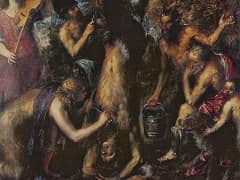Sacred and Profane Love, 1514 by Titian

Commissioned by Nicolo Aurelio, whose coat of arms it bears, on the occasion of his marriage to Laura Bagarotto in 1514, this celebrated painting did not receive the title by which it has come to be known until 1693, in an inventory of the Borghese collection; in the earliest preserved description of the work, from 1613, it is called "Beauty adorned and Beauty unadorned." Modern scholarship has continued to debate the significance of the subject, but most observers have instinctively recognized the composition as a form of dialogue. More precisely, the picture is organized according to what might be termed a dialectical structure: the field is clearly divided into two parts that are deliberately contrasted in every detail but at the same time, by virtue of the overall pictorial conception, they are synthetically resolved into a full unity. That the key factors in this dialectic are the two women is self-evident; the presence of Cupid and the roses between them confirms the amorous nature of the theme and the identification of these beauties as twin Venuses, a common theme in classical mythology and in both ancient and Renaissance philosophical speculation.
The sister deities, each dominating one half of the composition, represent two levels of love, the human and the divine, and each of the elements distinguishing them contributes to the articulation of this hierarchical relationship. The more exalted Venus is nude - heavenly beauty needs no material adornment - and stands higher in the field, framed against the background sky. She is set quite literally above earthly nature; the vertical instability of her body, requiring the actual support of her arm and the visual but - tressing of her crimson mantle, continues heavenward in the elevated eternal flame of her lamp - a vertical movement significantly reflected in the background accent of the distant bell tower. In contrast, her more earthly sister is solidly seated and hence actually on a lower level, more immediately enclosed by nature. She is sumptuously dressed in the material splendor of this world, and her attributes pertain to sanctioned human love: the myrtle she holds symbolizes the lasting happiness of marriage. Between these twin Venuses Cupid mixes the waters in the well, thereby suggesting an ideal synthesis of the two or a perfect harmony. Below celestial and human love, a third type is depicted on Titian's invented sarcophagus relief: bestial love - pure lust, which seeks not beauty and its procreation but rather mere satisfaction of sexual appetite - is symbolized by the unbridled horse and the accompanying acts of passionate violence.
Titian's composition, then, is a calculatedly structured and highly differentiated unity. The dense, closed forms and gravity of the left side contrast with the openness and volatility of the right; a system of horizontal coordinates, a basic stabilizing factor in the design, paralleling the long horizontal format of the canvas, defines a vertical hierarchy of upper and lower zones and hence of relative values. Within the substance of the picture's fictive world Titian further distinguishes levels of materiality, an upward scale from stone through jeweled cloth to unadorned flesh. To his sophisticated audience, the recognition of the formal source of the standing nude - a type common on ancient sarcophagi - would have seemed an ideal conceit to complete this cycle of references.















